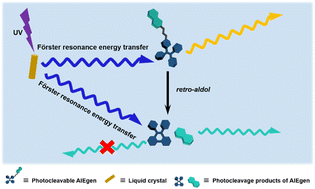Orthogonal integration of holographic and fluorescent dual images based on energy transfer from liquid crystals to a photocleavable AIEgen†
Abstract
Orthogonal integration of dual-mode optical images has become a hot topic in recent years due to the greatly increased information density, capacity and security. However, it remains challenging to improve the color diversity of the patterned images due to the stringent requirements of orthogonality during both image patterning and readout. Herein, we demonstrate a facile method to dial a fluorescent color when reconstructing dual images via Förster resonance energy transfer from liquid crystals (LCs) to a photocleavable AIEgen (e.g., TPE-Cou that comprises tetraphenylethylene and coumarin units). The energy transfer efficiency can be readily tuned from 0 to 99% by varying the TPE-Cou/LC weight ratio or controlling the photocleavage kinetics of TPE-Cou, making the fluorescent color readily tuned from blue-violet to yellow. Eventually, crosstalk-free integration of fluorescent and holographic dual-mode images has been successfully realized due to the orthogonality between the photocleavage reaction and holographic photopolymerization. Not only viewing-angle dependent structural color can be achieved owing to Bragg diffraction of the holographic patterns, but also multi-color fluorescent images can be encoded, which is highly promising for high security-level anticounterfeiting.

- This article is part of the themed collections: 2023 Journal of Materials Chemistry C HOT Papers, #MyFirstJMCC and Photofunctional Materials and Transformations


 Please wait while we load your content...
Please wait while we load your content...